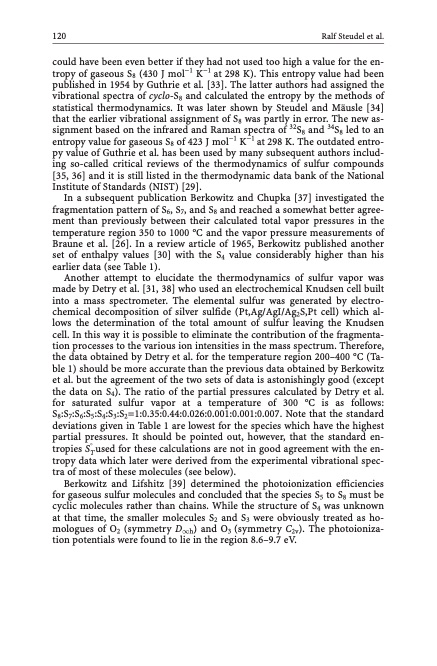
PDF Publication Title:
Text from PDF Page: 130
120 Ralf Steudel et al. could have been even better if they had not used too high a value for the en- tropy of gaseous S8 (430 J mol1 K1 at 298 K). This entropy value had been published in 1954 by Guthrie et al. [33]. The latter authors had assigned the vibrational spectra of cyclo-S8 and calculated the entropy by the methods of statistical thermodynamics. It was later shown by Steudel and Mäusle [34] that the earlier vibrational assignment of S8 was partly in error. The new as- signment based on the infrared and Raman spectra of 32S8 and 34S8 led to an entropy value for gaseous S8 of 423 J mol1 K1 at 298 K. The outdated entro- py value of Guthrie et al. has been used by many subsequent authors includ- ing so-called critical reviews of the thermodynamics of sulfur compounds [35, 36] and it is still listed in the thermodynamic data bank of the National Institute of Standards (NIST) [29]. In a subsequent publication Berkowitz and Chupka [37] investigated the fragmentation pattern of S6, S7, and S8 and reached a somewhat better agree- ment than previously between their calculated total vapor pressures in the temperature region 350 to 1000 C and the vapor pressure measurements of Braune et al. [26]. In a review article of 1965, Berkowitz published another set of enthalpy values [30] with the S4 value considerably higher than his earlier data (see Table 1). Another attempt to elucidate the thermodynamics of sulfur vapor was made by Detry et al. [31, 38] who used an electrochemical Knudsen cell built into a mass spectrometer. The elemental sulfur was generated by electro- chemical decomposition of silver sulfide (Pt,Ag/AgI/Ag2S,Pt cell) which al- lows the determination of the total amount of sulfur leaving the Knudsen cell. In this way it is possible to eliminate the contribution of the fragmenta- tion processes to the various ion intensities in the mass spectrum. Therefore, the data obtained by Detry et al. for the temperature region 200–400 C (Ta- ble 1) should be more accurate than the previous data obtained by Berkowitz et al. but the agreement of the two sets of data is astonishingly good (except the data on S4). The ratio of the partial pressures calculated by Detry et al. for saturated sulfur vapor at a temperature of 300 C is as follows: S8:S7:S6:S5:S4:S3:S2=1:0.35:0.44:0.026:0.001:0.001:0.007. Note that the standard deviations given in Table 1 are lowest for the species which have the highest partial pressures. It should be pointed out, however, that the standard en- tropies STused for these calculations are not in good agreement with the en- tropy data which later were derived from the experimental vibrational spec- tra of most of these molecules (see below). Berkowitz and Lifshitz [39] determined the photoionization efficiencies for gaseous sulfur molecules and concluded that the species S5 to S8 must be cyclic molecules rather than chains. While the structure of S4 was unknown at that time, the smaller molecules S2 and S3 were obviously treated as ho- mologues of O2 (symmetry D1h) and O3 (symmetry C2v). The photoioniza- tion potentials were found to lie in the region 8.6–9.7 eV.PDF Image | Topics in Current Chemistry

PDF Search Title:
Topics in Current ChemistryOriginal File Name Searched:
Elemental-Sulfur-und-Sulfur-Rich-Compounds-I.pdfDIY PDF Search: Google It | Yahoo | Bing
Sulfur Deposition on Carbon Nanofibers using Supercritical CO2 Sulfur Deposition on Carbon Nanofibers using Supercritical CO2. Gamma sulfur also known as mother of pearl sulfur and nacreous sulfur... More Info
CO2 Organic Rankine Cycle Experimenter Platform The supercritical CO2 phase change system is both a heat pump and organic rankine cycle which can be used for those purposes and as a supercritical extractor for advanced subcritical and supercritical extraction technology. Uses include producing nanoparticles, precious metal CO2 extraction, lithium battery recycling, and other applications... More Info
| CONTACT TEL: 608-238-6001 Email: greg@infinityturbine.com | RSS | AMP |